In reading, we recently finished up a week long unit teaching theme, and for the first time ever, it went fabulous! As of this blog post’s original date, this is my 3rd time teaching theme of literature, and to be honest, I have always struggled to find theme activities and resources to help my students really understand this tricky concept.
This year, the stars aligned and everything fell into place. Let’s take a look at the different activities and resources that I used to teach theme to my fifth graders and how I sequenced the different theme activities. Spoiler Alert: I think that the sequence of how I used the theme resources was key in my students’ mastery.
Theme Anchor Charts
We started off with a couple of theme anchor charts. I love using anchor charts to keep a running list of different examples of themes. I started this particular anchor chart with some common themes, and then we added to it as the students discovered more throughout the week. I really stressed how theme was a real-world connection or life-lesson, so they would understand that it was not specific to the story.
As we added more themes to the anchor chart, I still had a few students confusing themes with summaries, so we made a quick IS and IS NOT chart on the bottom of our second anchor chart.
Using Read Alouds to Teach Theme
With any reading skill or strategy that I teach, I always begin my reading instruction using read alouds (and often picture books). Using picture books is not only engaging for my 5th graders, but is also helps them initially begin to master a reading skill. Click here to read more reasons for using read alouds with 4th and 5th graders.
When they are presented a skill through something non-threatening (like a picture book) and having it read-aloud, students are able to focus on learning and applying the reading skill (versus focusing on decoding and comprehending at the same time). Click here to read more about my favorite read alouds for teaching theme.
After we went over the theme anchor chart and discussed the skill (as well as going over a few example themes), I then read 1-3 picture books (over the course of two days). Through guided practice and a lot of student discussion, we determined possible themes for the stories. We also (and this is important to do from the very beginning when teaching theme) analyzed the textual evidence that supported the theme.
Finally, we also made sure we discussed how the themes of the stories I read were different from the summaries of the stories. I always use this language when discussing this part with my students.
The theme needs to connect to the story but it should never be specific to a story. A summary is specific to one story. A theme is a statement that you can apply to your own life or another situation that may be vastly different from what happens in the story.
Want to see my recommended read alouds for teaching theme? Click here or on the image below.
Identifying Theme Practice
Once we were finished with our read-alouds, we began practicing theme using shorter texts and typically using texts found on task cards. I use two sets of theme task cards in my instruction and these task cards during the initial introduction.
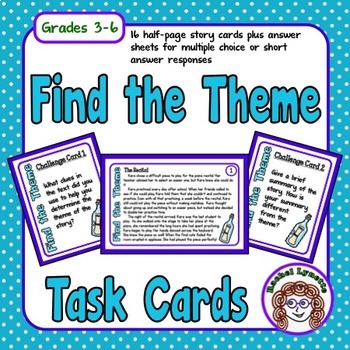
When reading these shorter stories as a class, we made sure that we not only identified the theme of the story, but also provided sufficient textual evidence to support that theme. We also wrote down any additional themes that the stories also had.
Small Group Theme Practice
Teacher-Led Group for Re-Teaching Theme
Midway through the week, I had my eye on those struggling students and knew I needed to get them in a small group before we moved on to passages that were longer in length. The biggest problem that they had was not fully understanding what a theme was and how that theme related to a story. They were constantly confusing theme with summary.
To support the students and re-teach theme, I began with a pictorial representation sort instead of stories. We looked at pictures that represented common themes. We discussed what was going on in the picture and connected that to a story.
After analyzing the content of the picture, I asked them what life-lesson they could learn from the picture. Then we connected life-lesson back to theme. Using the language of “life-lesson” and then connecting that back to theme was helpful for the students for sure. Finally, we looked for the card that contained a theme that best represented the picture.
We continued sorting the pictorial representation of the theme with the theme itself while I asked guiding questions and connected what they were doing to what they would do with a story.
Here are the pictorial representation cards that I used. {These are available in my Teaching Theme: Differentiated Unit.}
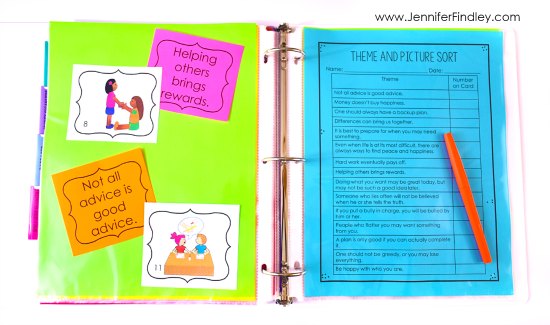
After practicing with the pictorial sort, the students were ready to apply this to short stories. I used my Theme Reading Puzzles for this part. The stories on these theme puzzles are shorter than those found on task cards, so we were able to practice the skill of identifying theme various times even in the short time-frame.
Theme Reading Centers
 In the other theme center, the students wrote short stories with a theme of their choosing from our chart or choosing a theme from a set of cards included in the reading center. They loved this theme activity because it allowed them to be creative. When they were finished writing their stories, they were able to switch with partners and practice identifying theme of each other’s stories. This theme activity is also available in my Theme Resource found on TPT.
In the other theme center, the students wrote short stories with a theme of their choosing from our chart or choosing a theme from a set of cards included in the reading center. They loved this theme activity because it allowed them to be creative. When they were finished writing their stories, they were able to switch with partners and practice identifying theme of each other’s stories. This theme activity is also available in my Theme Resource found on TPT.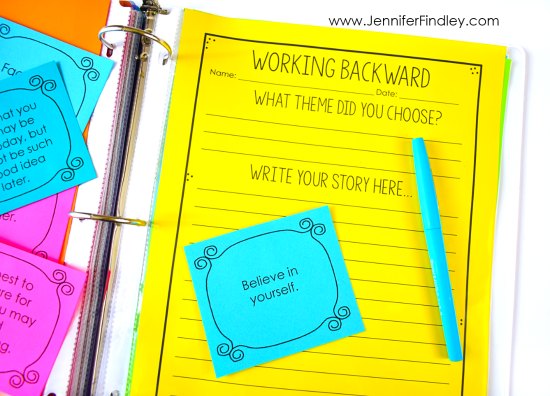
Identifying Theme with Lengthy Stories
After all of this, my students were finally ready to tackle a longer story and discover the theme. To make it interesting (and a little more engaging – I try to add in a small amount of novelty anytime I can), I also gave them an interactive notebook to go with the story. The students read a story from my Teaching Theme Unit, answered the question about theme, and then completed the interactive notebook template for their notebooks.
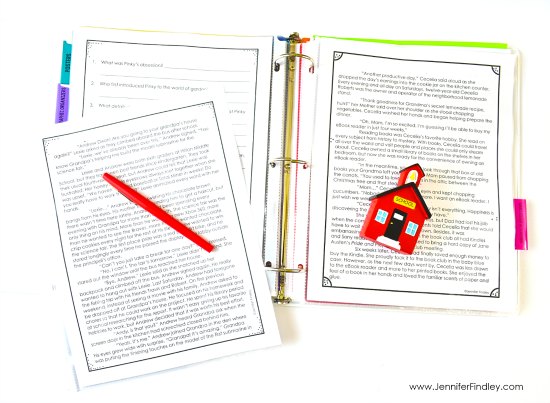
The students did a fabulous job with their first lengthy text! However, I know that if I would have started the unit with long passages instead of the read alouds and task cards, I would not have had so much success.
We finished the week with a few more long passages (There are four lengthier passages in my Theme Unit as well as five others that are about the same length or a little longer than those found on task cards.) Then we finally took a quick assessment to wrap up the skill, which all of my students mastered. I strongly believe my students mastered theme so quickly because of the sequence of instruction and the built-in reteaching with the various theme activities.
My Go-To Resource for Teaching Theme
- Teaching Posters and Essential Questions
- Graphic Organizers, Interactive Notebook Template, and Scoring Resources (a Rubric and Student Checklist).
- Three Sets of Passages (Five Short Stories, Four Longer Stories, and Two Paired Stories)
- Theme Task Cards
- Theme Small Group Activities
Click here or on the image below to see the Teaching Theme resource in my TPT store.
What are your favorite activities for teaching theme? Let me know in the comments!
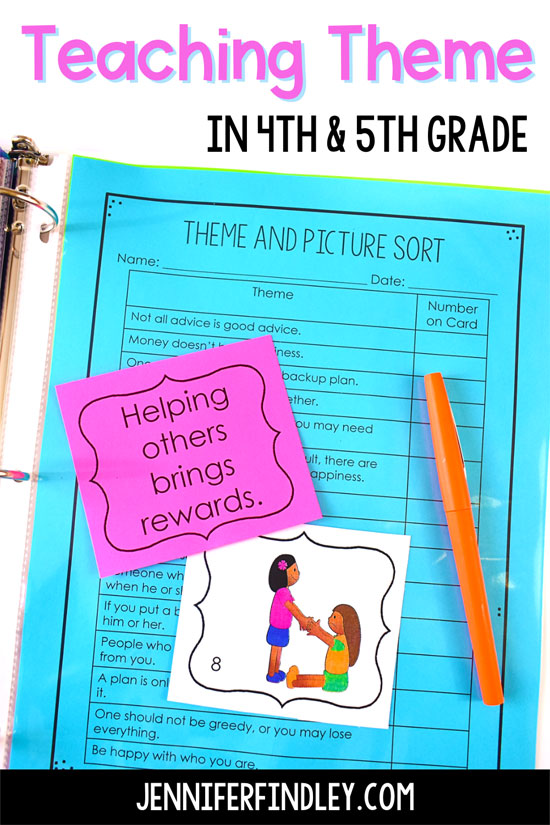
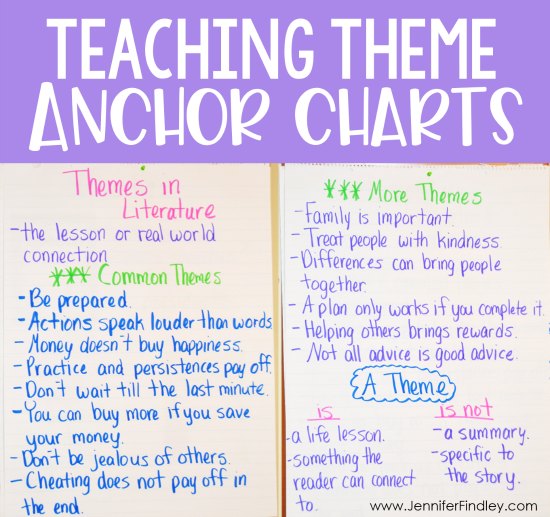
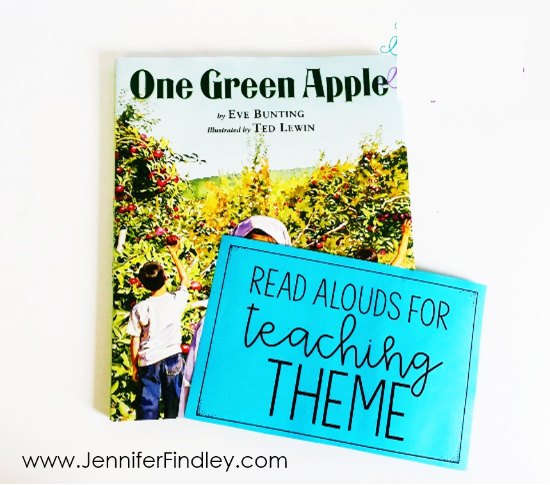
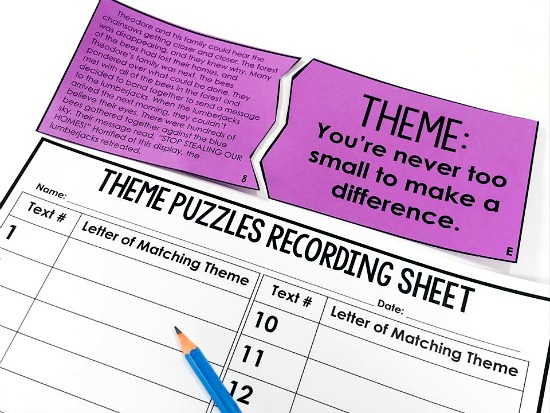
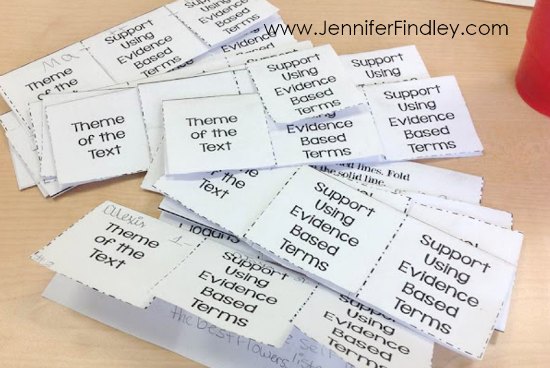

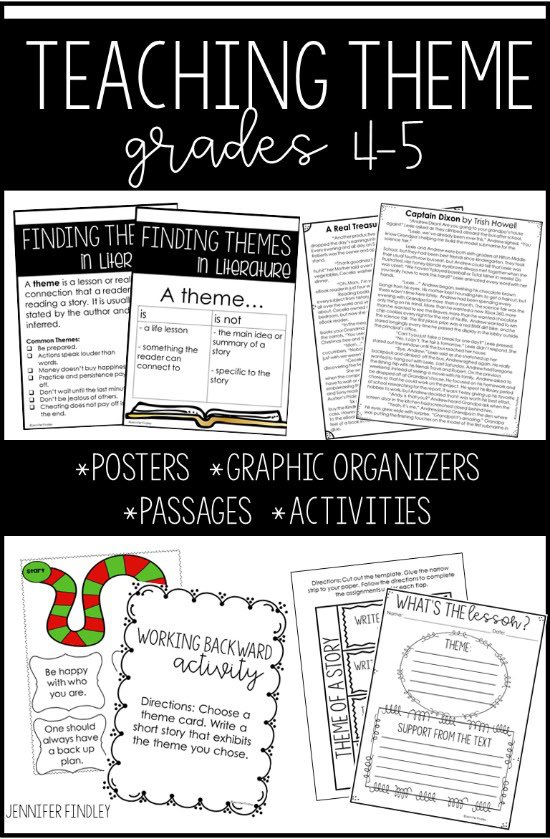







We just did a theme unit last week too! I wish I had known you were doing it too and I would have emailed you my theme task cards! If I get around to blogging about it, I will link to you so people can see what you did.
I love me some Rachel Lynette. She is my task card mentor, and she doesn't even know! lol
Love that flippable. I needed something like that!
Brandi
My Teacher Friend
Rachel's task cards are great, aren't they? Task cards are so much fun for kids….so less intimidating then passages. I would love to see a post about your theme cards!
Jennifer
Hey Jennifer. Love your Theme Unit. I teach 5th in Texas. Our push this year is focusing on differentiation. A standard I need suggestions is drawing conclusions in literature
Hey Jennifer-
Your week in theme looks great! Lots of great reinforcement and hands-on activities.
Thanks for the freebie – definitely storing that away for when we teach theme in a couple weeks.
We're focusing on cause and effect this week. I'm mixing in Valentine's Day and 100th day in there too, so it should be a very festive week!
~Jessica
Joy in the Journey
~Jessica
Jessica, cause and effect is a good skill to do during Valentine's Day week! I could see some integration going on with that!
Jennifer
My district has completely dove into Common Core (stressful now, but think it will be good in the long run) and theme has been a hard concept for my 4th and 5th grade classes. I loved teaching theme when I was in the classroom, so it took me a bit to figure out why with Common Core many 4th and 5th grade classrooms were struggling. I found that it was because they were missing the foundations of teaching theme which are in the previous standards (at least this is what I think). So long story short, those task cards and pictorial representations would be a great resource. Plus the flippable… Thank you so much for sharing it. I am happy your kiddos were successful with this. It is such a great feeling. 🙂
Antoinette
Antoinette, this was the first year that theme wasn't a struggle for my kids. However in the past the only resources I had were fables to use. Having better resources really makes a difference!
Jennifer
I love the idea of the pictorial representations as well, however, I could not find them in your TPT store. Are they easily accessible?
Love me some Flippable magic! Off to post it on Facebook!
Flippable Magic! I love that term!
I am your newest follower from the snowy state of WI. I love your post about teaching theme…it is a real tough skill for many kids, especially the struggling kids in my classroom. Thanks for these great ideas and a aidenote–my sister also lives in Dalton….so it was meant for me to find your site 🙂 Thanks for your generosity.
[email protected]
Jennifer,
WOW! It looks like your students really got a lot of quality instruction in Reading this week. I will definitely be working to use these ideas in my classroom. They make so much sense! I also love Rachel Lynette's products. They are genius! Thanks for sharing your ideas with us 🙂
Terry
Terry's Teaching Tidbits
Using pictures with struggling students is a great way to differentiate. Thanks for the tip!
This is such a great post about teaching theme! We are currently working with nonfiction in my classroom. We have already done theme, but I know once we're done with nonfiction and main idea, my kiddos are going to confused it with theme. I am so going to use your suggestions to reteach it!
Thank you for the lesson and freebie!
Amelia
wherethewildthingslearn
Wow, thanks for the shout out, Jennifer! I just found this post on Pinterest today and clearly, I am late for the party. It was fun reading the other comments! I am so glad these worked so well for you. I will be sure to pass your post along to my followers on Pinterest and Facebook.
Thanks for the freebie! I'll be using it this week.
Do you have the pictures and the theme to match those pictures?
Do you have the pictures and the theme to match those pictures?
Make them stop
Awesome post! It was exactly what I needed as we start our Theme Unit. Thank you so much for the wonderful post (I know it was a long time ago… but still helpful!)
MsBouchersbunch.blogspot.com
Where can I find the task cards by Rachel Lynnette?